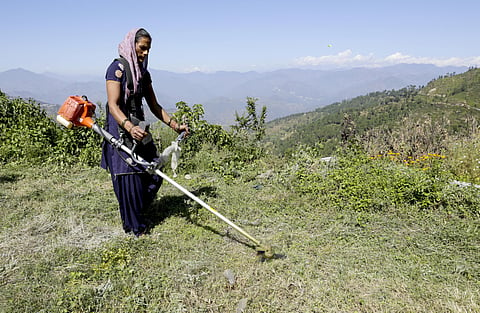

The Centre has issued guidelines for its recently launched National Mission on Natural Farming (NMNF) and invited feedback from state governments by December 7, 2024.
NMNF was launched on November 25, 2024 to promote natural farming in a mission mode and reduce farmers’ dependence on chemical inputs across the country. The operational guidelines propose a planned transition towards jan bhagidari (mass movement) for natural farming (NF) with location-specific solutions
The guidelines address various aspects, including establishing scientifically supported common standards, “easy farmer-friendly certification procedures”, a single national brand for naturally grown chemical-free produce, the creation of two separate bodies for policymaking and implementation and the training of 30,000 Krishi Sakhis (community resource persons).
Although the guidelines have not been released on the ministry’s website, they have been shared with state governments.
The mission is a standalone, centrally sponsored scheme under the Department of Agriculture & Farmers’ Welfare (DA&FW), Union Ministry of Agriculture & Farmers’ Welfare (MoA&FW), with an outlay of Rs 2,481 crore (Rs 1,584 crore from the Union government and Rs 897 crore from the states).
NF is a chemical-free farming practice involving livestock (preferably indigenous breeds of cattle), integrated NF methods, and diversified cropping systems aimed at improving soil health, reducing farmers’ input costs and enhancing climate resilience.
The mission seeks to introduce natural farming on 750,000 hectares, benefiting 10 million farmers across 15,000 clusters in willing Gram Panchayats (GP). These clusters will act as pilot areas where farmers will be trained in NF practices and generate on-ground experience.
Districts will identify suitable blocks for NMNF implementation. In each selected GP, contiguous areas totalling 50 hectares and approximately 125 farmers (with a maximum of 1 acre per farmer) will form clusters, based on farmers’ willingness to adopt NF.
Baseline and periodic real-time data will be maintained through an IT portal to track progress, monitor impact, and identify necessary policy support.
The guidelines identified priority districts where the mission will be implemented:
Namami Gange regions within a 5 kilometre corridor along the Ganga river
Districts on the banks of major river bodies as decided by the state
Districts with high fertiliser input sale in states
Districts with low fertiliser input sale in states
Districts with strong State Rural Livelihood Missions, Primary Agricultural Credit Societies, Farmer Producer Organisations or other Community-Based Organisations
Approximately 2,060 NF model demonstration farms will be established for hands-on training in natural farming — one on station farms and three on farmers’ fields by each of the 425 Krishi Vigyan Kendras (KVK) and 40 central and state agricultural universities.
The guidelines propose three distinct bodies: a National Steering Committee (NSC), a National Executive Committee (NEC) and a NF Cell.
While the NSC, chaired by MoA&FW, will be a policymaking body that will provide overall direction to the mission while also monitoring and reviewing its progress and performance, the NEC will be in charge of overall mission implementation and performance.
The NF cell, headed by a joint secretary for Integrated Nutrient Management Division would be responsible for the overall implementation of NMNF across the country. In addition, it will handhold the states, central institutions and other stakeholders in implementation and also carry out various activities such as capacity building, publicity, monitoring, impact evaluation, etc.
To scale up NF practices and knowledge, 30,000 trained Krishi Sakhis will provide farmer extension services to generate community-wide awareness and mobilise farmers to practice NF.
The Krishi Sakhis will receive on-field, hands-on training from scientists and experts associated with KVKs or agricultural universities. A team of two Krishi Sakhis will mobilise approximately 125 farmers to form a cluster and enrol them in NF practices at the start of each crop season.